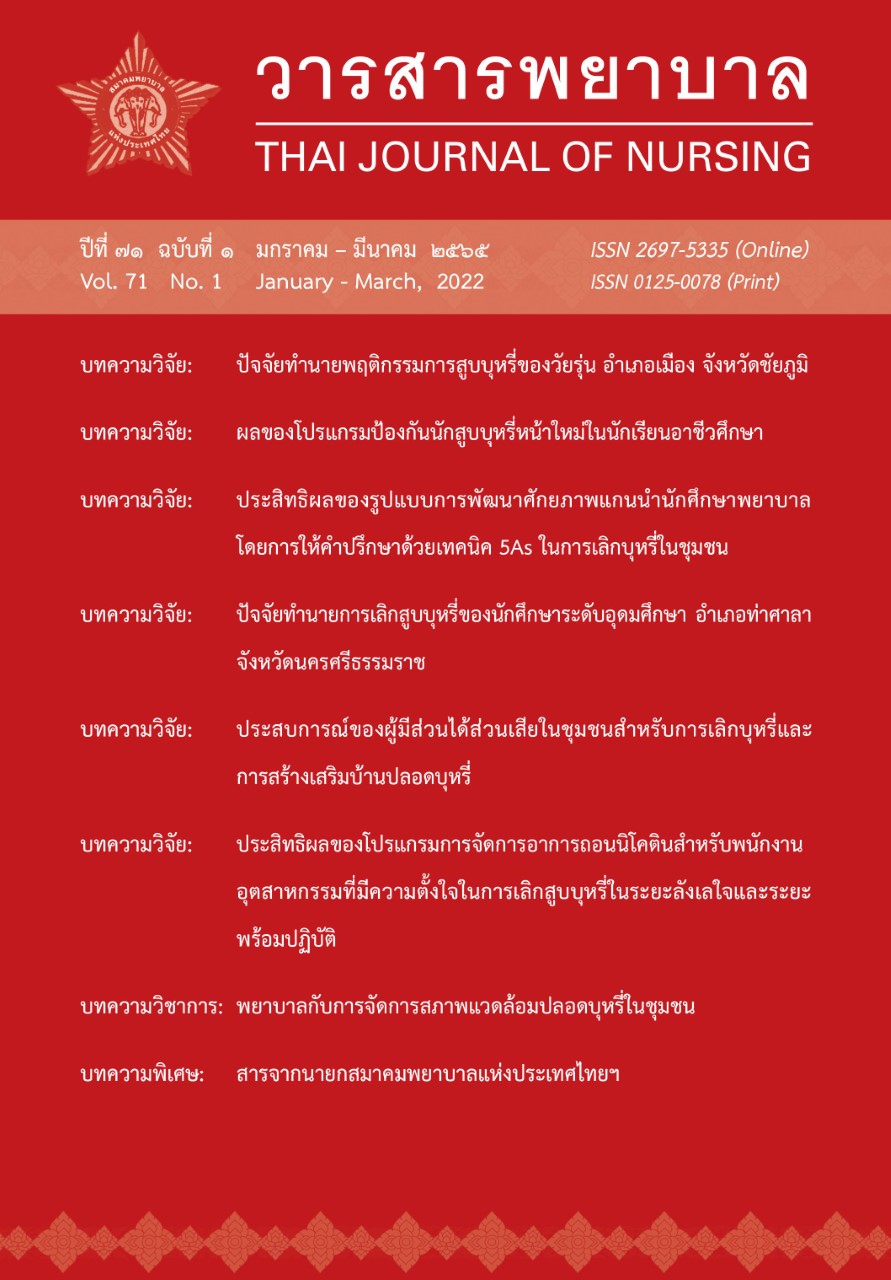Effects of the new smoker prevention program among vocational students
Main Article Content
Abstract
The objective of this quasi-experimental research was to examine effects of a new smoker prevention program for vocational students by applying the theory of planned behavior. The sample of 58 students were purposively selected. They were male vocational students, aged 15-18 years which were assigned into the experimental group (n = 29) and the comparison group (n = 29). Data collection was performed at pre-test, at post-test (week 4) and at follow-up (week 6). Percentage, frequency, mean, standard deviation, Chi-square test, Fisher's Exact test, Independent t-test, and Repeated Measures ANOVA were employed for data analyses. Results revealed that the experimental group’s attitudes toward smoking prevention behavior and intention not to smoke average scores at post-test and at follow up were greater than those at pre-test (p < .001). Comparing between groups at post-test and at follow-up revealed that the experimental group had greater average scores of attitudes toward smoking prevention behavior, subjective norm to smoking prevention behavior, perceived behavioral control on smoking prevention, and intention not to smoke than those of the comparison group (p < .05). However, the difference between groups of smoking prevention behavior average scores, at post-test and at follow up was not found.
Article Details

This work is licensed under a Creative Commons Attribution-NonCommercial-NoDerivatives 4.0 International License.
References
กระทรวงสาธารณสุข กรมควบคุมโรค สำนักงานควบคุมการบริโภคยาสูบ. (2559). ความ
รู้พื้นฐานและประเภทของผลิตภัณฑ์ยาสูบ (พิมพ์ครั้งที่ 2). นนทบุรี: ไนซ์ เอิร์ธ
ดีไซน์.
จิราพร สุวะมาตย์, สุรินธร กลัมพากร, และสุนีย์ ละกำปั่น. (2558). ผลของโปรแกรมการ
สูบบุหรี่สำหรับวัยรุ่นชายตอนต้นในสถานสงเคราะห์. วารสารพยาบาล, 64(1), 1-11.
จุลจีรา จันทะมุงคุณ, ณัฐิกา ราชบุตร, และสุริยา ราชบุตร. (2561). ผลของโปรแกรมการ
พัฒนาศักยภาพร่วมกับแรงสนับสนุนทางสังคมเพื่อป้องกันการสูบบุหรี่ในกลุ่
เยาวชน ตำบลบ้านยาง อำเภอเมือง จังหวัดบุรีรัมย์. วารสารโรงพยาบาลสกลนคร,
(1), 35-47.
จีรภัทร์ รัตนชมภู, และณรงค์ศักดิ์ หนูสอน. (2563). การป้องกันนักสูบบุหรี่หน้าใหม่
สังคมไทยต้องเปลี่ยนแปลง. วารสารวิทยาลัยพยาบาลบรมราชชนนี อุตรดิตถ์,
(1), 13-27.
ธีรผล หล่อประดิษฐ์. (2559). ผลของโปรแกรมป้องกันการสูบบุหรี่ของนักเรียน
มัธยมศึกษาตอนต้นโรงเรียนขยายโอกาส อำเภอศีรีมาศ จังหวัดสุโขทัย
(วิทยานิพนธ์ปริญญามหาบัณฑิต ไม่ได้ตีพิมพ์). มหาวิทยาลัยนเรศวร, พิษณุโลก.
ประกิต วาทีสาธกกิจ. (2562). การสูบบุหรี่ของเยาวชน (รายงานวิจัย). กรุงเทพมหานคร:
มูลนิธิรณรงค์เพื่อการไม่สูบบุหรี่.
ปรียานุช อุทัยรัศมี, รุ่งรัตน์ ศรีสุริยเวศน์, และพรนภา หอมสินธุ์. (2563). ผลของ
กระบวนการระดมพลังสร้างสรรค์ชุมชนต่อทัศนคติและความตั้งใจในการไม่สูบบุหรี่
ของวัยรุ่นชายในสถานสงเคราะห์. วารสารพยาบาลศาสตร์, 43(1), 10-18.
มหาวิทยาลัยมหิดล ศูนย์วิจัยและจัดการความรู้เพื่อการควบคุมยาสูบ. (2562). รายงาน
สถานการณ์การบริโภคยาสูบของประเทศไทย พ.ศ.2562 (พิมพ์ครั้งที่ 1).
กรุงเทพมหานคร: สินทวีกิจ พริ้นติ้ง.
เสาวลักษณ์ มะเหศวร, พรนภา หอมสินธุ์, และรุ่งรัตน์ ศรีสุริยเวศน์. (2561). ปัจจัยที่มี
ความสัมพันธ์กับการทดลองสูบบุหรี่ของนักเรียนอาชีวศึกษาหญิง จังหวัด
ฉะเชิงเทรา. วารสารพยาบาลสาธารณสุข, 32(1), 31-43.
สิทธิพงศ์ วัฒนานนท์สกุล. (2561). ประสิทธิผลของโปรแกรมเชิงป้องกันการสูบบุหรี่โดย
เน้นโรงเรียนเป็นฐานที่มีผลต่อผลลัพธ์การรู้คิดเกี่ยวกับการสูบบุหรี่ ในนักเรียนชั้น
มัธยมศึกษาตอนต้น เขตกรุงเทพมหานคร. วารสารการวิจัยและพัฒนาหลักสูตร,
(1), 193-219.
Ajzen, I. (2005). Attitudes, personality and behavior (2nd ed.). Berkshire,
UK: Open University Press
Polit, D. F., & Hungler, B. P. (1999). Nursing research: Principles and
methods (6thed.). Philadelphia: Lippincott.
Zeidi, I. M., & Agha, A. H. (2013). Effectiveness of an education
intervention based on theory of planned behavior to reduce
intentions to smoke among secondary school student. Journal of
Research & Health, 3(4), 504-513.


